Prevention Of Infectious Disease

Please email your certificate of completion ccasitedirector@gmail. Com for CCA or allaboutgca@gmail. Com for GCA.
- 1.
What is the correct multi step procedure for cleaning & disinfecting a surface in the classroom?
- 2.
An illness that can be spread from one person to another either indirectly or directly is called...
- A.
Communicable disease
- B.
The flu
- C.
Bacteria
- D.
Parasite
Correct Answer
A. Communicable diseaseExplanation
A communicable disease refers to an illness that can be transmitted from one individual to another, either through direct contact or indirectly through objects, air, or vectors like insects. This term encompasses a wide range of infectious diseases caused by various agents such as bacteria, viruses, parasites, or fungi. It highlights the ability of the disease to spread and infect others, emphasizing the importance of taking preventive measures to control its transmission.Rate this question:
-
- 3.
Young children are at a greater risk of infection of a communicable disease.
- A.
True
- B.
False
Correct Answer
A. TrueExplanation
They have not been exposed to the most common germs & have habits that spread germs.Rate this question:
-
- 4.
The number one way to reduce the spread of superficial infections is __________________.
Correct Answer
hand washing
wash your hands
handwashingExplanation
The most effective method to decrease the transmission of superficial infections is through proper hand hygiene. Hand washing, washing your hands, or handwashing all refer to the same action of cleaning hands with soap and water or using hand sanitizers. This practice helps remove germs and prevent their transfer from one person to another, reducing the spread of superficial infections.Rate this question:
- 5.
Preschool teachers should perform a quick ____________________ of each child every day upon arrival and before the parent leaves.
- A.
Head count
- B.
Health assesment
- C.
Diagnosis
- D.
File check
Correct Answer
B. Health assesmentExplanation
Preschool teachers should perform a quick health assessment of each child every day upon arrival and before the parent leaves. This is important to ensure the well-being and safety of the children in the preschool. By conducting a health assessment, teachers can quickly identify any signs of illness or discomfort in the child, such as fever, cough, or runny nose. This allows them to take appropriate measures, such as informing parents, isolating the child if necessary, or seeking medical attention. Regular health assessments also help in monitoring the overall health and development of the children in the preschool.Rate this question:
-
- 6.
Why do you make bleach water fresh daily?
- A.
Recommended by the Center of Disease Control
- B.
It looses it's concentration/effectiveness after 24 hours
- C.
To have something else to do
- D.
Just because
Correct Answer(s)
A. Recommended by the Center of Disease Control
B. It looses it's concentration/effectiveness after 24 hoursExplanation
Bleach water is recommended to be made fresh daily because it loses its concentration and effectiveness after 24 hours. This means that if the bleach water is not used within 24 hours, it may not be as effective in killing germs and disinfecting surfaces. Making fresh bleach water daily ensures that it is at its maximum potency and can effectively kill bacteria and viruses, as recommended by the Center for Disease Control.Rate this question:
-
- 7.
It is necessary to use separate sinks for diapering/toileting & food related routines.
- A.
True
- B.
False
Correct Answer
A. TrueExplanation
Environmental Rating Scales states if the same sink is used by children or adults for both diapering/toileting and food related routines (including tooth brushing) or for other purposes, it must be sanitized by spraying sink and faucets with a bleach solution after each use. OR use separate sinksRate this question:
-
- 8.
Hand sanitizer is ok to take the place of hand washing.
- A.
True
- B.
False
Correct Answer
B. FalseExplanation
Hand sanitizer for adult use can be used in ADDITION to hand washing, not in place of.Rate this question:
-
- 9.
If I use gloves when changing a child's diaper (or any other procedure) I do not have to wash my hands.
- A.
True
- B.
False
Correct Answer
B. FalseExplanation
Gloves are an extra preventative, but DOES NOT take the place of hand washing.Rate this question:
-
Quiz Review Timeline +
Our quizzes are rigorously reviewed, monitored and continuously updated by our expert board to maintain accuracy, relevance, and timeliness.
-
Current Version
-
Mar 21, 2023Quiz Edited by
ProProfs Editorial Team -
Sep 17, 2013Quiz Created by
Cjensen
- Addiction Quizzes
- AIDS Quizzes
- Allergic Quizzes
- Allergy Quizzes
- Alzheimer Quizzes
- Anemia Quizzes
- Arthritis Quizzes
- Asthma Quizzes
- Bipolar Disorder Quizzes
- Burn Quizzes
- Cancer Quizzes
- Cerebral Palsy Quizzes
- COPD Quizzes
- Dengue Quizzes
- Depression Quizzes
- Diabetes Quizzes
- Disorder Quizzes
- Gastrointestinal Disease Quizzes
- Headache Quizzes
- Hepatitis Quizzes
- Hypertension Quizzes
- Influenza Quizzes
- Insomnia Quizzes
- Lung Cancer Quizzes
- Lung Disease Quizzes
- Malaria Quizzes
- Neoplasia Quizzes
- Obesity Quizzes
- Osteoporosis Quizzes
- Pandemic Quizzes
- Personality Disorder Quizzes
- Pneumonia Quizzes
- Pulmonology Quizzes
- Sexually Transmitted Disease Quizzes
- Sinus Quizzes
- SLE Quizzes
- Stroke Quizzes
- Thyroid Disease Quizzes
- Tuberculosis Quizzes
- Ulcer Quizzes
- Viral Quizzes


